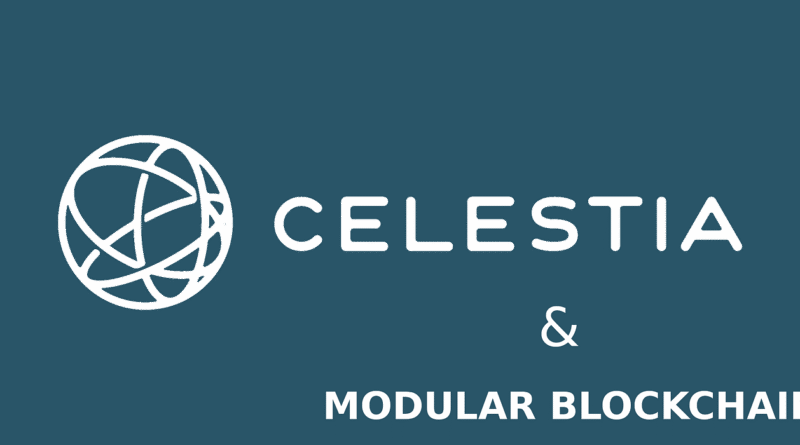Celestia and the Rise of Modular Blockchains Explained
Introduction
The blockchain industry has long grappled with the “blockchain trilemma”—balancing scalability, security, and decentralization. Traditional monolithic blockchains like Bitcoin and Ethereum handle all core functions (consensus, execution, and data availability) within a single layer, often leading to bottlenecks, high fees, and limited throughput. Celestia, launched in October 2023, pioneers a modular blockchain approach, decoupling these functions to enhance scalability and flexibility. This article explores Celestia’s role in the rise of modular blockchains, its technology, and its impact on the crypto ecosystem in 2025.
What Are Modular Blockchains?
Unlike monolithic blockchains, which perform all tasks (consensus, execution, data availability, and settlement) on a single chain, modular blockchains split these functions across specialized layers. This separation allows each layer to optimize for its specific role, improving efficiency, scalability, and developer flexibility. Key components include:
- Consensus Layer: Ensures nodes agree on transaction order and validity.
- Data Availability (DA) Layer: Guarantees transaction data is accessible for verification.
- Execution Layer: Processes transactions and smart contracts.
- Settlement Layer: Finalizes transactions and resolves disputes.
Modular blockchains, like Celestia, enable developers to build custom chains (e.g., rollups) tailored to specific use cases, such as DeFi, gaming, or tokenized real-world assets (RWAs), while leveraging a shared DA and consensus layer for security.
What Is Celestia?
Celestia is the first modular Layer-1 blockchain, focusing exclusively on consensus and data availability while outsourcing execution and settlement to other chains or rollups. Built using the Cosmos SDK and Tendermint consensus algorithm, Celestia allows developers to deploy their own blockchains (sovereign rollups) as easily as smart contracts, without needing to bootstrap a validator set. Its native token, TIA, powers staking, governance, and blobspace fees, driving network security and usage.
Celestia’s mainnet, launched on October 31, 2023, marked the start of the “modular era,” with over $56.5 million in funding from investors like Bain Capital Crypto and Polychain Capital, achieving a $1 billion valuation. In 2025, Celestia’s ecosystem supports a growing number of rollups and dApps, making it a cornerstone of modular blockchain innovation.
How Celestia Works
Celestia’s modular architecture decouples blockchain functions, focusing on two core roles:
- Consensus: Celestia orders transactions and ensures network agreement using Tendermint, a fast and secure consensus mechanism.
- Data Availability (DA): Celestia publishes transaction data, making it available for verification by light nodes without requiring them to download entire blocks.
Key technical features include:
- Data Availability Sampling (DAS): Light nodes randomly sample small portions of block data to verify availability, achieving over 99% confidence with multiple samples (e.g., seven samples yield >99% probability). DAS scales with the number of light nodes, enabling Celestia to handle massive data throughput without compromising decentralization.
- Erasure Coding: Expands block data (e.g., a 1MB block becomes 2MB) so that only 50% of the data is needed to reconstruct the entire block, enhancing fault tolerance.
- Blobspace: Introduced via Ethereum’s Proto-Danksharding (EIP-4844), blobs are large data chunks rollups post to Celestia for DA, reducing costs compared to Ethereum’s mainnet. Protocols pay TIA fees for blobspace, driving economic demand.
Celestia does not execute transactions or run smart contracts, leaving these tasks to rollups (e.g., Optimistic or ZK-rollups) or other chains like Ethereum for settlement. This specialization makes Celestia a “blockspace-as-a-service” (BAAS) provider, enabling scalable, secure infrastructure for dApps.
Celestia’s Role in the Rise of Modular Blockchains
In 2025, Celestia is driving the modular blockchain revolution through technological and ecosystem advancements. Below are its key contributions:
- Unprecedented Scalability
Celestia’s DA layer scales dynamically with user growth. As more light nodes join, DAS allows higher data throughput without increasing node resource demands. The Lemongrass upgrade (September 2024) and Ginger upgrade (2025) doubled throughput by reducing block times from 12 to 6 seconds, targeting over 1 GB/s data capacity. This enables Celestia to support thousands of rollups, each processing millions of transactions per second (TPS), far surpassing monolithic chains like Ethereum (~15 TPS).
- Cost Efficiency for Rollups
Rollups, critical for Layer-2 scaling, rely on DA layers to publish transaction data. Celestia’s low-cost blobspace (fees ~$0.01–$0.10 per blob) reduces rollup operating costs by orders of magnitude compared to Ethereum’s mainnet ($1–$10 per transaction). Projects like Doma (tokenizing 360 million domains) and Kamigotchi (on-chain gaming) leverage Celestia’s DA for affordable, high-throughput dApps.
- Sovereign Rollups and Developer Freedom
Celestia enables developers to create sovereign rollups—independent chains with custom execution environments—without needing a validator set. Tools like Rollkit allow rollups to deploy on Celestia in minutes, inheriting its DA and consensus security. Developers can choose execution layers (e.g., EVM, WASM) and settlement layers (e.g., Ethereum, CEVMOS), fostering innovation in DeFi, NFTs, and SocialFi.
- Enhanced Decentralization
By reducing node requirements, Celestia makes verification accessible to users with modest hardware. Light nodes, using DAS, verify DA without downloading full blocks, lowering barriers to participation. The initial validator set is capped at 100 for efficiency, with TIA staking incentivizing security via proof-of-stake. This approach contrasts with monolithic chains, where high hardware demands (e.g., Ethereum’s 10TB archive nodes) centralize validation.
- Interoperability and Ecosystem Growth
Celestia integrates with the Cosmos ecosystem and supports Ethereum rollups, creating a multi-chain future. The CEVMOS settlement layer, an EVM-based Cosmos SDK chain, optimizes rollup settlement as a Celestia rollup using Optimint (a Tendermint replacement). Projects like Converge (RWA and DeFi), Noble (stablecoin apps), and Towns (on-chain communication) build on Celestia, showcasing its versatility. In 2025, Celestia’s ecosystem hosts over 50 rollups, with $500 million in TVL.
- Lazybridging and ZK Integration
Celestia’s roadmap includes Lazybridging, using zero-knowledge (ZK) proofs for seamless asset bridging across rollups, enhancing user experience. Native ZK verification on Celestia’s base layer, planned for 2025, will enable trustless interoperability, making modular ecosystems feel unified.
Impact on the Crypto Ecosystem in 2025
Celestia’s modular approach is reshaping the crypto landscape:
- DeFi and RWAs: Converge unifies RWAs and DeFi with Celestia’s DA, handling $200 million in tokenized assets.
- Gaming and NFTs: Kamigotchi’s fully on-chain gameplay leverages Celestia’s high throughput, supporting 1 million daily transactions.
- Consumer Crypto: Abstract’s vision for consumer apps uses Celestia to scale user-friendly dApps, onboarding millions.
- Developer Adoption: Modular Bangkok (November 2024) and ETHDenver (February 2025) events highlight Celestia’s appeal, with workshops training 1,000+ developers.
- Economic Sustainability: TIA’s tokenomics, with controlled inflation and blobspace fees, incentivize validator participation and network growth. TIA’s market cap exceeds $5 billion in 2025, reflecting strong demand.
Challenges and Considerations
Despite its promise, Celestia faces hurdles:
- Competition: DA layers like Avail and EigenDA challenge Celestia’s dominance, offering alternative solutions for rollups.
- Complexity: Modular ecosystems require developers to manage multiple layers, increasing technical overhead.
- Security Risks: While DAS and erasure coding enhance DA, misconfigured rollups could introduce vulnerabilities.
- Economic Viability: TIA’s value depends on blobspace demand. Low rollup adoption could limit fee revenue, impacting validator incentives.
The Future of Celestia and Modular Blockchains
In 2025, Celestia is poised to solidify its leadership in the modular blockchain space:
- Scalability Milestones: The Fusaka-like upgrades (post-Ginger) aim for 10 GB/s throughput, supporting millions of rollups.
- Ecosystem Expansion: Partnerships with Movement Labs and ContributionDAO drive rollup adoption, targeting 100+ rollups by Q4 2025.
- TIA as Modular Money: Growing blobspace demand positions TIA as the reserve currency for modular ecosystems, with $1 billion in annual fee revenue.
- Web3 Innovation: Celestia’s infrastructure enables new use cases, from AI-driven dApps to tokenized internet domains (Doma’s 360 million domains).
Vitalik Buterin’s endorsement of modular designs, citing Celestia’s DA proofs, underscores its industry impact. The shift from monolithic to modular blockchains, championed by Celestia, aligns with Ethereum’s rollup-centric roadmap, heralding a scalable, decentralized Web3 future.
Conclusion
Celestia’s modular blockchain model, with its focus on data availability and consensus, is revolutionizing scalability and developer freedom in 2025. By enabling sovereign rollups, reducing costs, and scaling with user growth, Celestia addresses the blockchain trilemma, powering a new wave of dApps in DeFi, gaming, and beyond. Despite challenges like competition and complexity, Celestia’s robust technology and vibrant ecosystem position it as a leader in the modular era. For crypto enthusiasts, developers, and investors, Celestia represents a gateway to the future of blockchain innovation.




